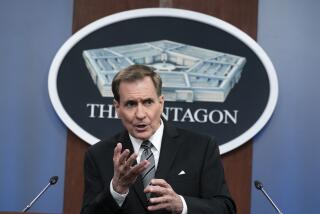Navy Asks Why Stark Failed to Turn Around
- Share via
WASHINGTON — The Navy’s investigation into the Iraqi missile attack on the U.S. frigate Stark is now focused on the question of why the ship’s crew did not maneuver into a defensive posture that could have enabled it to warn off the Iraqi plane before its sea-skimming missiles were launched, sources familiar with the probe said Monday.
Pentagon officials refused any on-the-record comment about the ongoing investigation, but sources who declined to be identified confirmed that Capt. Glenn R. Brindel and three other officers have been assigned legal counsel and could be held culpable in the May 17 tragedy.
The Pentagon has said that the Stark twice sent voice warnings in English to the Iraqi jet that it was approaching an American vessel, but the Iraqi government has said that the pilot denied hearing any such warning before firing missiles at the ship.
Could Not Use Radar
At the time that the two missiles ripped through the hull of the Stark, killing 37 members of the crew in an explosion and fire, the vessel was on a heading that made it impossible for it to use its target- illumination radar, its other means for conveying a warning, or its Phalanx gun, which is designed to shoot down incoming missiles.
Both systems are aft of the ship’s highest points, which create a blind spot that make it impossible to bring the target-acquisition radar or the Phalanx to bear on a target approaching, as the two missiles did, from nearly dead ahead.
Because the ship’s air-search radar began tracking the Iraqi plane at a distance of about 225 miles, investigators are seeking to determine why the ship was not brought about to eliminate the blind spot.
Sources said that focusing the target-illumination radar would have “lit up” the oncoming Mirage fighter, triggering a light in the cockpit that would have let the Iraqi pilot know that he was about to be fired upon. The radar also would have been able to detect the oncoming missiles.
As it was, the ship was not aware that the missiles had been launched until the first one was sighted by a crewman just seconds before impact.
Time to Swing Around
Although the Stark was moving at a speed of only four to six knots, the sources said, there was time for the vessel to swing around into a defensive position during the minutes that the plane was being tracked. The New York Times first reported that the Navy’s investigation was focusing on this aspect of the tragedy.
Sen. Jim Sasser (D-Tenn.), who visited the Persian Gulf last week, said Monday that the destroyer Waddell, operating in the same area as the Stark, turned away an approaching Iraqi jet May 14 and May 15.
Veered Away From Waddell
On one of those days, Sasser said a plane came within 40 miles of the Waddell, within the range of the Exocet missile. At that point, the Waddell turned on the target-illumination radar, and the approaching plane veered sharply away.
According to sources familiar with operations in the gulf, rules of engagement called for American ships to first ask an approaching plane to identify itself, to follow with a second request, then indicate by voice that the ship will fire, and then, if there is no response, to “light up” the cockpit with the target-illumination radar.
There was no indication Monday when the Navy expects to conclude its investigation of the incident. However, the Reagan Administration moved ahead with plans to beef up the U.S. naval presence in the gulf in connection with its agreement to give American-flag protection to Kuwaiti tankers.
Reagan to Lobby Allies
In remarks commemorating the 40th anniversary of the Marshall Plan, President Reagan indicated Monday that he will put the issue of “common security interests” before allied nations that have so far declined to join the United States in protecting the international sea lanes of the gulf.
More to Read
Sign up for Essential California
The most important California stories and recommendations in your inbox every morning.
You may occasionally receive promotional content from the Los Angeles Times.










